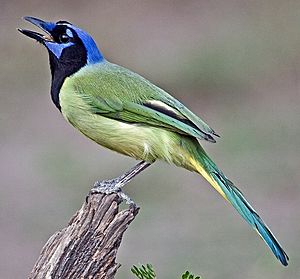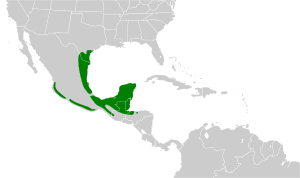Green jay facts for kids
Quick facts for kids Green jay |
|
|---|---|
 |
|
| A green jay in Texas | |
| Conservation status | |
| Scientific classification | |
| Genus: |
Cyanocorax
|
| Species: |
luxuosus
|
 |
|
The green jay (Cyanocorax luxuosus) is a colorful bird found in Central America. It belongs to a group of birds called New World jays. These birds are about 27 centimeters (11 inches) long. Their colors can change a bit depending on where they live.
Green jays usually have blue and black heads. Their wings and back are green. Their tails are a bluish-green color. They have black beaks and dark legs. Their eyes can have yellow or brown rings around them. Green jays eat many things like insects, small animals, seeds, and fruit. They often build their nests in thorny bushes. The female bird lays three to five eggs. The green jay is a common bird. Experts say it is a "least concern" species. This means it is not in danger of disappearing.
Contents
About the Green Jay
Some bird experts think the green jay is very similar to the Inca jay. The Inca jay lives in the Andes mountains. These experts believe they might be the same species. They would call the green jay C. yncas luxuosus. The Inca jay would be C. yncas yncas.
What Green Jays Look Like
Green jays are usually between 25 and 29 centimeters (10 to 11 inches) long. They weigh about 66 to 110 grams (2.3 to 3.9 ounces). The feathers on their heads, cheeks, and neck are yellowish-white with blue tips. Some green jays have more blue than others.
Their chests and undersides can be bright yellow. This is true for birds in the south. Birds in the north, like in Texas, have pale green undersides. Their upper parts are a rich green color. Green jays have special feathers near their nose called nasal bristles. These can form a clear tuft in some types of green jays. The color of their eyes can be dark brown or bright yellow. This also depends on the specific type of green jay.
Green Jay Behavior
Green jays eat many different things. They like insects and other small creatures without backbones. They also eat various cereal grains. If they find ebony (Ebenopsis spp.) seeds, they will eat those. They also enjoy oak tree acorns. Green jays will often hide acorns to eat later.
They will also eat meat and human food scraps if they get the chance. Green jays are clever birds. They have been seen using small sticks as tools. They use these sticks to pull insects out from under tree bark.
Green Jay Reproduction
Green jays usually build their nests in a tree. They also like thorny bushes or thickets. The female bird lays about three to five eggs. Only the female bird sits on the eggs to keep them warm. This is called incubating. Both parents work together to take care of the young birds once they hatch.
Green Jay Calls
Like most jays, the green jay has many different sounds it can make. Its most common call sounds like "rassh-rassh-rassh". But they can make many other unusual noises too. One of their most special calls sounds just like an alarm bell ringing!
Where Green Jays Live
The green jay lives from southern Texas all the way to Honduras. The similar Inca jay lives in a separate area. It is found in the northern Andes mountains of South America.
Green Jay Status
The green jay is a common bird species. It lives across a very wide area. This bird can adapt well to different places. Its population is actually growing. This is because clearing forests can create new places for them to live. No major threats have been found for the green jay. The International Union for Conservation of Nature says it is a "least concern" species. This means it is not at risk of becoming extinct.
- Green jay species account at Neotropical Birds (Cornell Lab of Ornithology)
- Cyanocorax yncas in Field Guide: Birds of the World on Flickr
Images for kids



